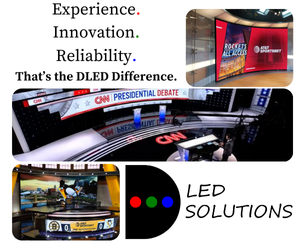NextGen TV narrows gap between broadcast and streaming

Subscribe to NewscastStudio for the latest news, project case studies and product announcements in broadcast technology, creative design and engineering delivered to your inbox.
The ATSC 3.0 standard, marketed as NextGen TV, provides broadcasters with capabilities that narrow technical and functional disparities between traditional over-the-air broadcasting and internet-based streaming services.
As deployment continues across the U.S., industry stakeholders report that these advancements address key competitive disadvantages that broadcasters have faced in the streaming era.
NextGen TV’s ability to deliver on-demand functionality represents a shift for broadcasters competing with streaming platforms, enabling viewers to control experiences previously unavailable via an antenna.
“Start over” capability has emerged as a priority feature, allowing viewers who tune in late to restart programs from the beginning. NBC implemented this functionality during its Olympic coverage, setting a template that local broadcasters are following.
“NBC rolled out across all their platforms in next gen, the NBC application in preparation for the Olympics that had start over, which is the first feature ever been deployed here,” said Anne Schelle, who leads Pearl TV. “It’s been deployed and something that consumers know well in streaming.”
Gray Media plans to extend this capability to local news programming.
“We want to enable start over in all of our newscasts. If someone tunes into our evening news at 6:08, we want them to be able to hit the start over button and start from the very beginning,” said Rob Folliard, SVP of government relations and distribution at Gray Media.
“So that’s a project that’s on the fast track,” Folliard added. “NBC definitely raised the bar with their broadcast app and what they did with the Olympics. And start over, I think was very popular with the Olympics. I think it’ll be just as popular with local news because it’s an on demand world. People don’t tune in at six o’clock. They tune in when they just happen to turn on their TV and we need to be able to start the program over to meet what our consumers expectations are and not what our schedule might say.”
The NextGen TV standard also enables time-shifting beyond program restart.
“Consumers enjoy new functionality and enhanced programming, including the ability to pause and rewind programs, a feature previously mainly reserved for streaming services,” said Mary Crebassa, VP of major accounts at LTN.
Application-based interface
The integration of broadcaster-controlled applications into NextGen TV mirrors the user interface experience that streaming providers offer, creating a more interactive viewing environment.
“NextGen TV creates an environment that very much mimics what Gen Zs are used to, which is the ability to start over, to have applications, to find out more information, more content, more access to the news, ways of looking at things in very modernized viewing environment,” Schelle said.
The Internet Protocol foundation of ATSC 3.0 facilitates web-like interactivity.
“NextGen TV is based on Internet Protocol (IP), just like online video services, and uses web languages for interactivity, so you can expect more innovation and new services, bringing consumers the best combination of online and broadcast television,” said Suzana Brady, SVP of worldwide sales and marketing for Cobalt Digital.
Broadcast applications can deliver supplementary content alongside linear programming.
“NextGen TV unlocks new interactive features that transform local programming. From hyperlocal weather forecasts, news segments, and overlay information during sports games or shopping programs to interactive maps and personalized viewer guides, NextGen TV changes how viewers consume and engage with content,” Crebassa said.
The ATSC 3.0 standard was designed to integrate over-the-air delivery with internet connectivity, creating a hybrid distribution system that combines the efficiency of broadcast with internet-delivered personalization.
“Speaking specifically about NGA, I think the biggest shift is going from channel-based audio to object-based. Streaming and hybrid broadcast-OTT are much more adaptable to implementing these new technologies, and even approaching NGA staged implementation phases,” said Costa Nikols, executive-team strategy advisor for media & entertainment at Telos Alliance.
This hybrid approach allows broadcasters to deliver linear programming efficiently via broadcast while providing additional content and services via broadband, similar to how streaming platforms operate.
“Investments in new transmitters and middleware solutions are also key, allowing broadcasters to deliver hybrid broadcast-internet experiences while maintaining efficiency,” said Steve Edwards, VP, broadcast distribution, Rohde & Schwarz.
Content discovery and personalization
NextGen TV enables improved content discovery and personalization features that have been strengths of streaming platforms.
“The enhancements around immersive and personalization features can be added based on takeup and adoption,” Nikols said.
Personalization extends to advertising as well, providing viewers with more relevant commercial content.
“A viewer seeing an addressable ad can also be served an interactive overlay showing sales or offers specific to the nearest store. With just one click, the consumer can access more details or personalized offers,” Crebassa said.
The standard supports enhanced EPGs (electronic program guides) with more detailed metadata.
“Relevant and interactive content keeps consumers ‘switched on’ and boosts engagement, opening up more monetization opportunities for broadcasters and advertisers,” said Crebassa.
This relies, of course, on improved audience measurement capabilities, providing detailed viewership data.
“Improved audience measurement and targeted advertising could make over-the-air television far more attractive to advertisers, helping broadcasters compete more effectively for ad revenue,” said Edwards.
This data collection capability supports the targeted advertising models that have been central to streaming platforms’ revenue strategies.
Technical quality advancements
NextGen TV also addresses the advantage of streaming services in visual and audio quality by supporting advanced formats previously unavailable through traditional broadcast standards.
“NextGen TV is a huge leap from traditional broadcasting, making a real difference in picture and sound quality with 4K, HDR, and immersive audio,” said Edwards..
Some broadcasters have prioritized High Dynamic Range implementation as a means of competing with streaming quality.
“We’ve been rolling out HDR and Atmos. We focused initially on our NBC stations in advance of the Olympics. So we got as many of our NBCs up before the Olympics up mapping to HDR and getting Dolby Atmos on a bunch of them for the superior sound,” Folliard said.
Audio improvements include dialogue enhancement, a feature common in streaming apps.
“With dialogue enhancement, every word is clear, so viewers don’t have to rewind, and won’t miss out on important parts,” Nikols said.
Signal robustness and reliability
NextGen TV addresses the vulnerability of streaming to bandwidth constraints and internet congestion during high-viewer events.
EdgeBeam Wireless, a joint venture between E.W. Scripps Company, Gray Media, Nexstar Media Group, and Sinclair, plans to leverage this to provide datacasting services.
“EdgeBeam will be able to deliver data across the country to any civilian or military device with an ATSC 3.0 receiver, such as cars and trucks, drones, marine vessels, phones, tablets, and television sets,” according to company documentation.
EdgeBeam Wireless identified content delivery network assistance as a key application for ATSC 3.0.
“EdgeBeam can help provide a significantly improved viewer experience for streaming services, without buffering or lag, particularly during high-profile events with large audiences, such as live sports,” according to the company.
The broadcast standard offers reliability that internet-only delivery cannot match during peak usage periods or in areas with limited internet infrastructure.
“It also enhances transmission robustness through a hybrid OTA and OTT delivery model,” said Tsviatko Jongov, product manager at MainConcept.
Market position and adoption challenges
Despite technological parity advancements, industry executives acknowledge that NextGen TV still faces adoption challenges that streaming services do not.
“I think we need to get the ATSC3 technology in more devices. That’s, I think, the number one thing in my book is to see more devices with that technology enabled in it,” Crebassa said.
Television manufacturers have increasingly integrated NextGen TV reception capability, with multiple brands now offering compatible sets.
“We’ve really spent this last year focusing on the delivery of new services for consumers. So we built out to 76 percent coverage over the last four years, worked really hard to get TV manufacturers to adopt next gen TV as well as set-top box makers,” Schelle said.
The industry recognizes the need to maintain broadcast’s content advantage while adopting streaming-like technologies.
“Really broadcast without a doubt has the most popular and the best content that’s out there. Every month, Nielsen releases its breakdown of what people are watching, including streaming, cable networks, and over-the-air broadcasts. And every single month, it’s the same thing. The most popular programming, the stuff that everybody wants to watch, live sports, news, and other big events, they’re on broadcast,” Folliard said.
“What we’ve missed is that we don’t have the usability features, the easy features that streaming offers. And that’s what NextGen is going to give us,” he added. “It’s going to give us the same viewing experience that consumers like with streaming. So it’s taking the best content, which is on broadcast, and marrying it with the best technology. And I think if you put that together, that is a very powerful combination.”
The transition timeline established through regulatory decisions will affect how quickly broadcasters can fully implement the new standard.
Of course, streaming and NextGen TV are two different ways of enjoying content and are not mutually exclusive. They both present different pros and cons for viewers, but for local stations to continue weathering declining OTA viewership, these features provide an advantage in leveling the means of distribution.
The National Association of Broadcasters has petitioned the FCC to sunset ATSC 1.0 by 2028 in major markets, with complete transition by 2030.
Subscribe to NewscastStudio for the latest news, project case studies and product announcements in broadcast technology, creative design and engineering delivered to your inbox.








tags
Anne Schelle, Cobalt Digital, Costa Nikols, Gray Media, LTN, MainConcept, Mary Crebassa, NextGen TV ATSC 3.0, Pearl TV, Rob Folliard, Rohde & Schwarz, Steve Edwards, Suzana Brady, Telos Alliance, Tsviatko Jongov
categories
Broadcast Engineering, Broadcast Industry News, Featured, NextGen TV